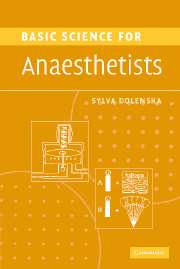Book contents
- Frontmatter
- Contents
- List of abbreviations and symbols
- List of figure captions
- Forewords
- Preface
- Preface to the second edition
- Part 1 Physics, mathematics, statistics, anaesthetic apparatus
- 1 Gas compression, relationship of volume, pressure and temperature
- 2 Real gas compression
- 3 Flow and resistance
- 4 Heat, vaporization and humidification
- 5 Simple mechanics 1: mass, force, pressure
- 6 Simple mechanics 2: work and power
- 7 Mathematical concepts
- 8 Exponentials 1: the curves
- 9 Exponentials 2: properties of exponential decay curve
- 10 Descriptive statistics
- 11 Presentation of data
- 12 Receiver operating characteristic curve
- 13 Gas supply and pressure
- 14 The circle system
- 15 The Mapleson A (Magill) breathing system
- 16 T-pieces
- 17 Lung filling with automatic lung ventilators
- Part 2 Clinical measurement
- Part 3a Physiology: the cardiovascular system
- Part 3b Physiology: the respiratory system
- Part 4 Pharmacology
- Further Reading
- Index
5 - Simple mechanics 1: mass, force, pressure
from Part 1 - Physics, mathematics, statistics, anaesthetic apparatus
Published online by Cambridge University Press: 13 August 2009
- Frontmatter
- Contents
- List of abbreviations and symbols
- List of figure captions
- Forewords
- Preface
- Preface to the second edition
- Part 1 Physics, mathematics, statistics, anaesthetic apparatus
- 1 Gas compression, relationship of volume, pressure and temperature
- 2 Real gas compression
- 3 Flow and resistance
- 4 Heat, vaporization and humidification
- 5 Simple mechanics 1: mass, force, pressure
- 6 Simple mechanics 2: work and power
- 7 Mathematical concepts
- 8 Exponentials 1: the curves
- 9 Exponentials 2: properties of exponential decay curve
- 10 Descriptive statistics
- 11 Presentation of data
- 12 Receiver operating characteristic curve
- 13 Gas supply and pressure
- 14 The circle system
- 15 The Mapleson A (Magill) breathing system
- 16 T-pieces
- 17 Lung filling with automatic lung ventilators
- Part 2 Clinical measurement
- Part 3a Physiology: the cardiovascular system
- Part 3b Physiology: the respiratory system
- Part 4 Pharmacology
- Further Reading
- Index
Summary
Mass is a fundamental quantity; the other above-mentioned mechanical quantities are derived from it. Its unit, 1 kilogram, is a basic SI (Système Internationale) unit. Mass means ‘quantity of matter’. This description is more or less a tautology; it shows the difficulty in defining the fundamental. Our perception of mass is that of weight, or of an object's opposition to an attempt to move it, which means applying force. In physics, weight in fact is a force, defined as the product of mass and acceleration: F = m.a. Its unit is 1 newton (N) or 1 kg m per s2. The gravitational pull is the same in most places on Earth, and gives all objects an acceleration of 9.81 m per s−2. Thus weight is directly proportional to mass, and the two quantities are interchangeable. The kilogram is therefore used as a unit of weight, instead of newton, which is the correct unit. The relationship between mass and weight can be readily demonstrated on weighing scales: 1 kg of mass placed on one side of the scale produces a force (weight) of 9.81 newtons. Consequently, when training operating department assistants, to exert a force of 20 to 40 newtons (for the application of cricoid pressure), the weight they should be aiming for on the scales is 2 to 4 kg.
- Type
- Chapter
- Information
- Basic Science for Anaesthetists , pp. 18 - 21Publisher: Cambridge University PressPrint publication year: 2006



